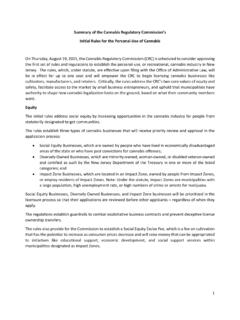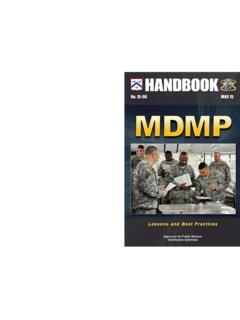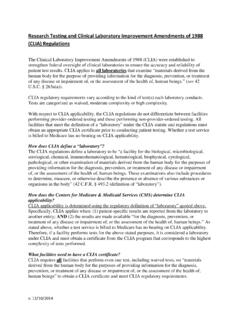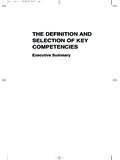Transcription of Guideline on Summary of requirements for active …
1 European Medicines Agency Public 7 Westferry Circus, Canary Wharf, London, E14 4HB, UK Tel. (44-20) 74 18 84 00 Fax (44-20) 74 18 85 95 E-mail: EMEA 2004 Reproduction and/or distribution of this document is authorised for non commercial purposes only provided the EMEA is acknowledged CHMP/QWP/297/97 Rev 1 corr EMEA/CVMP/1069/02 COMMITTEE FOR MEDICINAL PRODUCTS FOR HUMAN USE (CHMP) COMMITTEE FOR MEDICINAL PRODUCTS FOR VETERINARY USE (CVMP) Guideline ON Summary OF requirements FOR active SUBSTANCES IN THE QUALITY PART OF THE DOSSIER DISCUSSION IN THE QALITY WORKING PARTY (QWP) October 2002 TRANSMISSION TO CPMP/CVMP December 2002 RELEASE FOR CONSULTATION January 2003 DEADLINE FOR COMMENTS June 2003 DISCUSSION IN THE QUALITY WORING PARTY (QWP)
2 April 2004 ADOPTION BY CHMP AND CVMP June 2004 DATE FOR COMING INTO OPERATION 1 February 2005 NOTE: This Guideline is applicable to both Human and Veterinary medicinal products. It supersedes the Guideline requirements in relation to active substances 3AQ6a, which was published in Volume 3A and referred to in Volume 7B. CHMP/QWP/297/97 rev 1 and EMEA/CVMP/1069/02 EMEA 2004 2/10 Guideline ON Summary OF requirements FOR active SUBSTANCES IN THE QUALITY PART OF THE DOSSIER TABLE OF CONTENTS Guideline ON Summary OF requirements FOR active SUBSTANCES IN THE QUALITY PART OF THE DOSSIER ..2 1. CLASSIFICATION OF active 2. FEASIBLE WAYS TO SUBMIT THE REQUIRED INFORMATION.
3 3 Certificate of Suitability to the Monograph of the European Pharmacopoeia (CEP).. 4 active Substance Master File (ASMF) Procedure .. 4 Full details of manufacture ..5 Other supportive data in consideration of the qualification of impurities .. 5 3. NEW active SUBSTANCES ..6 4. EXISTING active SUBSTANCES NOT DESCRIBED IN THE EUROPEAN PHARMACOPOEIA OR A PHARMACOPOEIA OF AN EU MEMBER STATE ..6 5. EXISTING active SUBSTANCES DESCRIBED IN THE EUROPEAN PHARMACOPOEIA OR THE PHARMACOPOEIA OF AN EU MEMBER STATE ..7 Inorganic substances .. 8 Herbal drugs and herbal drug 8 Organic substances (isolated from material of animal or human origin).
4 8 Organic substances (synthetic or semi-synthetic or isolated from herbal sources or from micro-organisms) .. 8 CHMP/QWP/297/97 rev 1 and EMEA/CVMP/1069/02 EMEA 2004 3/10 Summary OF requirements FOR active SUBSTANCES IN THE QUALITY PART OF THE DOSSIER The legal basis for this Guideline is: Directive 2001/82/EC and 2001/83/EC of the European Parliament and of the Council of 6 November 2001 on the Community code relating to medicinal products for veterinary and human use, respectively. Commission Directive 2003/63/EC of 25 June 2003, amending Directive 2001/83/EC of the European Parliament and of the Council on the Community code relating to medicinal products for human use.
5 This Guideline is intended to provide guidance regarding the requirements to be included for chemical and herbal active substances in the quality part of the dossier, depending on the described classification. Biological active substances and immunological active substances, as defined in Annex I of the Directive 2001/82/EC and Directive 2001/83/EC, as amended, are excluded from the scope of this Guideline . 1. CLASSIFICATION OF active SUBSTANCES active substances can be classified into: new active substances, used for the first time in a medicinal product either for human or veterinary use existing active substances not described in the European Pharmacopoeia ( ) or the pharmacopoeia of an EU Member State existing active substances described in the or in the pharmacopoeia of an EU Member State active substances can further be divided into.
6 Inorganic substances herbal drugs and herbal drug preparations organic substances (isolated from material of animal or human origin) organic substances (synthetic or semi-synthetic or isolated from herbal sources or micro-organisms) 2. FEASIBLE WAYS TO SUBMIT THE REQUIRED INFORMATION Depending on the kind and classification of the active substance, the required data may generally be submitted in one of the following three ways see sections , and For new active substances option or would apply. For existing substances option (where applicable) has the advantage of generally avoiding any subsequent reassessment.
7 Options or are also applicable. Option may be in addition to option and option and can only be considered as a specific option in very exceptional cases. CHMP/QWP/297/97 rev 1 and EMEA/CVMP/1069/02 EMEA 2004 4/10 Certificate of Suitability to the Monograph of the European Pharmacopoeia (CEP) The active substance manufacturer should submit documentation to the European Pharmacopoeia Secretariat with a view to evaluating the suitability of the pharmacopoeial monograph in relation to the manufacturing method actually used, cf. Appendix I of the Council of Europe Resolution AP-CSP (99) 4 Certification of Suitability to the Monographs of the European Pharmacopoeia.
8 The Applicant should include a copy of the most current CEP in the dossier, together with a written assurance that no significant changes in the manufacturing method have taken place following the granting of the certificate or its last revision. Along with the CEP, the Applicant should supply results of batch analysis demonstrating compliance with the monograph and including any additional tests/limits listed on the CEP ( residual solvents, additional impurity tests). In the case of sterile substances, the Applicant should make sure that a full of the sterilisation process as specified on the CEP as well as results of any tests applied (in particular the test of the monograph) and validation data are provided in the application file.
9 The CEP may not necessarily address all relevant parameters and in these cases the Applicant should supply additional data, stability data to support a retest period (only if retest date not mentioned on the CEP), physico-chemical characteristics such as particle size and polymorphism. active Substance Master File (ASMF) Procedure Full details of chemistry, manufacturing process , quality controls during manufacture and process validation for the active substance may be submitted in a active Substance Master File as outlined in the Guideline active Substance Master File Procedure EMEA/CVMP/134/02 or CPMP/QWP/227/02).
10 In such cases, The Applicant s Part needs to be included in the marketing authorisation (MA) application. Proof of structure may not be necessary where this can be shown by specific identification tests in relation to reference substances sufficiently described in the dossier. In the case of pharmacopoeial active substances: Stability data may not be necessary where adequate literature evidence can be cited and summarised and where the monograph covers the degradation products for which suitable limits have been set as indicated in the Note for Guidance Stability testing on Existing active Substances and Related Finished Products (EMEA/CVMP/846/99 or CPMP/QWP/122/02).














